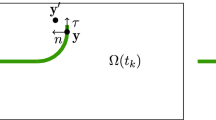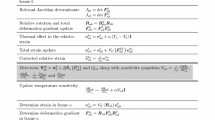Abstract
In the context of the eXtended Finite Element Method (X-FEM), the use of two level set functions allows the representation of the crack to be achieved regardless of the mesh. The initial crack geometry is represented by two distinct level set functions, and the crack propagation is simulated by an update of these two level set functions. In this paper, we propose a new approach, based on the Fast Marching Method (FMM), to update the level set functions. We also propose a new implementation of the FMM, designed for tetrahedral volume meshes. We then extend this method to all types of volume elements (tetrahedra, hexahedra, pentahedra, pyramids) available in a standard finite element library. The proposed approach allows one to use the same mesh to solve the mechanical problem and to update the level set functions. Non-planar quasi-static crack growth simulations are presented to demonstrate the robustness of the approach, compared to existing methods based on the integration of Hamilton-Jacobi equations or geometric approaches.






















Similar content being viewed by others
References
Barr BIG, Brokenshire DR (1996) Torsion fracture tests. BRE Digest
Barth TJ, Sethian JA (1998) Numerical schemes for the Hamilton–Jacobi and Level Set equations on triangulated domains. J Comput Phys 145(1):1–40
Baydoun M, Fries TP (2012) Crack propagation criteria in three dimensions using the XFEM and an explicit-implicit crack description. Int J Fract 178(1–2):51–70
Belytschko T, Black T (1999) Elastic crack growth in the finite elements with minimal remeshing. Int J Numer Meth Eng 45(5):601–620
Bronstein AM, Bronstein MM, Kimmel R (2007) Weighted distance maps computation on parametric three-dimensional manifolds. J Comput Phys 225(1):771–784
Chan SK, Tuba IS, Wilson WK (1970) On the finite element method in linear fracture mechanics. Eng Fract Mech 2(1):1–17. https://doi.org/10.1016/0013-7944(70)90026-3
Chopp D (2001) Some improvements of the fast marching method. Soc Ind Appl Math 23:230–244
Citarella R, Buchhloz FG (2008) Comparison of crack growth simulation by DBEM and FEM for SEN-specimen undergoing torsion or bending loading. Eng Fract Mech 75(3–4):489–509
Colombo D (2012) An implicit geometrical approach to level sets update for 3D non planar X-FEM crack propagation. Comput Methods Appl Mech Eng 237–240:39–50
Colombo D, Massin P (2011) Fast and robust level set update for 3D non-planar X-FEM crack propagation modelling. Comput Methods Appl Mech Eng 200(25–28):2160–2180
Destuynder P, Djaoua M (1981) Sur une Interprétation Mathématique de l’Intégrale de Rice en Théorie de la Rupture Fragile. Math Methods Appl Sci 3(1):70–87. https://doi.org/10.1002/mma.1670030106
EDF (1989–2021) Finite element \({code_aster}\), analysis of structures and thermomechanics for studies and research. Open source on www.code-aster.org
Erdogan F, Sih GC (1963) On the crack extension in plates under plane loading and transverse shear. J Basic Eng 85(4):519–525
Fu Z, Kirby RM, Whitaker RT (2013) A fast iterative method for solving the Eikonal equation on tetrahedral domains. SIAM J Sci Comput 35(5):C473–C494
Geniaut S, Galenne E (2012) A simple method for crack growth in mixed mode with X-FEM. Int J Solids Struct 49(15–16):2094–2106. https://doi.org/10.1016/j.ijsolstr.2012.04.015
Gosz M, Moran B (2002) An interaction energy integral method for computation of mixed-mode stress intensity factors along non-planar crack fronts in three dimensions. Eng Fract Mech 69(3):299–319. https://doi.org/10.1016/S0013-7944(01)00080-7
Gravouil A, Moes N, Belytschko T (2002) Non-planar 3D crack growth by the extended finite element and level sets—Part II: level set update. Int J Numer Meth Eng 53(11):2569–2586
Irwin GR (1957) Analysis of stresses and strains near the end of a crack traversing a plate. J Appl Mech 24:361–364
Jefferson AD, Barr BIG, Bennett T, Hee SC (2004) Three dimensional finite element simulations of fracture tests using the Craft concrete model. Comput Concr 1(3):261–284
Kimmel R, Sethian JA (1998) Computing geodesic paths on manifolds. Proc Natl Acad Sci USA 95(15):8431–8435
Lazarus V, Buchholz FG, Fulland M, Wiebesiek J (2008) Comparison of predictions by mode II or mode III criteria on crack front twisting in three or four point bending experiments. Int J Fract 153(2):141–151
Li FZ, Shih CF, Needleman A (1985) A comparison of methods for calculating energy release rates. Eng Fract Mech 21(2):405–421. https://doi.org/10.1016/0013-7944(85)90029-3
Moes N, Dolbow J, Belytschko T (1999) A finite element method for crack growth without remeshing. Int J Numer Meth Eng 46(1):131–150
Moes N, Gravouil A, Belytschko T (2002) Non-planar 3D crack growth by the extended finite element and level sets—Part I: mechanical model. Int J Numer Meth Eng 53(11):2549–2568
Nicolas G, Fouquet T, Geniaut S, Cuvilliez S (2016) Improved adaptive mesh refinement for conformal hexahedral meshes. Adv Eng Softw 102:14–28. https://doi.org/10.1016/j.advengsoft.2016.07.014
Osher S, Sethian JA (1988) Fronts propagating with curvature dependent speed: algorithms based on Hamilton–Jacobi formulations. J Comput Phys 79(1):12–49
Paris P, Erdogan F (1963) A critical analysis of crack propagation laws. J Basic Eng 85(4):528–533
Prabel B, Combescure A, Gravouil A, Marie S (2007) Level set X-FEM non matching meshes: application to dynamic crack propagation in elastic-plastic media. Int J Numer Meth Eng 69(8):1553–1569
Sethian JA (1996) A marching level set method for monotonically advancing fronts. Proc Natl Acad Sci USA 93(4):1591–1595
Sethian JA (1999) Fast Marching Methods. SIAM Rev 41(2):199–235
Sethian JA, Vladimirsky A (2000) Fast methods for the Eikonal and related Hamilton–Jacobi equations on unstructured meshes. Proc Natl Acad Sci USA 97(11):5699–5703
Sethian JA, Vladimirsky A (2003) Ordered upwind methods for static Hamilton–Jacobi equations: theory and algorithms. SIAM J Numer Anal 41(1):325–363
Shi J, Chopp D, Lua J, Sukumar N, Belytschko T (2010) Abaqus implementation of extended finite element method using a level set representation of three-dimensional fatigue crack growth and life predictions. Eng Fract Mech 77(14):2840–2863
Stolarska M, Chopp DL, Moes N, Belytschko T (2001) Modelling crack growth by level sets in the extended finite element method. Int J Numer Meth Eng 51(8):943–960
Su X, Yang Z, Liu G (2010) Finite element modelling of complex 3D static and dynamic crack propagation by embedding cohesive elements in abaqus. Acta Mech Solida Sin 23(3):271–282. https://doi.org/10.1016/S0894-9166(10)60030-4
Sukumar N, Chopp DL, Moran B (2003) Extended finite element method and fast marching method for three-dimensional fatigue crack propagation. Eng Fract Mech 70(1):29–48
Sukumar N, Chopp DL, Béchet E, Moes N (2008) Three-dimensional non-planar crack growth by a coupled extended finite element and fast marching method. Int J Numer Meth Eng 76(5):727–748
Writh K, Dreiding AS (2014) Relations between edge lengths, dihedral and solid angles in tetrahedra. J Math Chem 52:1624–1638
Acknowledgements
We sincerely thank the two anonymous reviewers whose suggestions helped us to improve this manuscript.
Author information
Authors and Affiliations
Corresponding author
Additional information
Publisher's Note
Springer Nature remains neutral with regard to jurisdictional claims in published maps and institutional affiliations.
Rights and permissions
About this article
Cite this article
Le Cren, M., Martin, A., Massin, P. et al. A robust 3D crack growth method based on the eXtended Finite Element Method and the Fast Marching Method. Int J Fract 235, 243–265 (2022). https://doi.org/10.1007/s10704-022-00632-4
Received:
Accepted:
Published:
Issue Date:
DOI: https://doi.org/10.1007/s10704-022-00632-4




